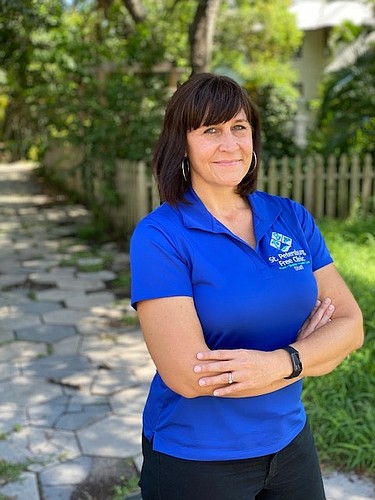For good, ill or somewhere in between, timing is everything — a fact of which Jennifer Yeagley, who became CEO of the St. Petersburg Free Clinic on Feb. 28, is now all too aware.
Yeagley, 44, joined the organization two weeks before the coronavirus pandemic would strain the clinic’s resources to the breaking point. Demand at its food pantry shot up by 300%. The majority of its 450 volunteer staff members, many of whom are retirees, had to quarantine and were unable to work. (The clinic, founded in 1970, receives most of its funding from private donors and has 60 paid staff members. It has $19.4 million in annual revenue, according to its most recent tax filing.)
As the public health crisis expanded into an economic catastrophe, the clinic’s food pantry served more than 18,000 people in April alone, and Yeagley says more than half had never taken advantage of food assistance programs.
“The numbers in our food pantry, exponentially, just went through the roof,” she says. “On a busy day, it used to be that we would be serving 150, maybe 170 households; a really busy day would be 200. In April, we were serving between 400 and 700 households a day.”
‘The difference between what we do and what businesses do — it's a tax designation; it’s how we bring dollars in.’ Jennifer Yeagley, CEO of St. Petersburg Free Clinic
How did a still wet-under-the-ears CEO manage to successfully lead the organization through such a sudden and unexpected crisis?
First, Yeagley drew from previous experience, specifically her time at Clearwater-based Gulf Coast Jewish Family & Community Services, where was vice president for administrative and strategic operations. In that role, she worked under GCJFS President and CEO Sandra Braham, whom she cites as a mentor who encouraged and supported her ambitions.
“She gave me her blessing to pursue a different opportunity — that was very liberating,” Yeagley says. “It made me feel like I didn't have to feel guilty about having conversations with the free clinic about what my leadership career could look like.”
Yeagley also learned key lessons about how to run a nonprofit like a business. So much so that she says the longer she works in the nonprofit world, the fewer distinctions she sees between it and the for-profit realm.
“The difference between what we do and what businesses do — it's a tax designation; it’s how we bring dollars in,” Yeagley says. “We support our patients through raising donations, but the execution of the work is the same. Our ‘sales and revenue generation’ looks different, but at the end of the day, we are delivering a service and, in some cases, a product to our end user, our end consumer.”
And like for-profit business leaders, Yeagley had to navigate sudden operational shifts. Although most of the clinic’s staff, both paid and voluntary, work in front-line positions at the organization’s food bank, health center or the residences it operates for homeless men and women, some office staff had to be set up for remote work. Yeagley also had to quickly implement lessons she and her team were learning on the fly, such as converting the food pantry into a drive-thru facility.
“People would check in and have a seat and wait for their chance to move through the food pantry, which is set up like a grocery store,” Yeagley says. “We had to move that outside. But within three or four days of doing that, we realized that it was inefficient because we can't serve all the folks who were coming to us. So it became a drive-thru/walk-up, and within a week of doing, things became more efficient.”
Funding during the height of the COVID-19 shutdown was another challenge for Yeagley. She didn’t panic, but she also didn’t go to extremes to find new sources of operating capital. Instead, mindful of the axiom that it’s easier to sell to an existing customer than acquire a new one, she called for more frequent touch points with the clinic’s donor base.
“We were communicating very regularly to what we were seeing and how we were responding,” Yeagley says. “In the first two and a half months of COVID-19, we were sending out a weekly email to our community of supporters. And then they forwarded that on to their communities.”
The result was not only an outpouring of support from existing donors but around 1,000 new supporters, as well.
“Within weeks,” Yeagley says, “we saw a lot of donations come in, … many from folks who had already given to the free clinic, and they increased the amount that they may have typically given — and in some cases, to a pretty significant degree.”






